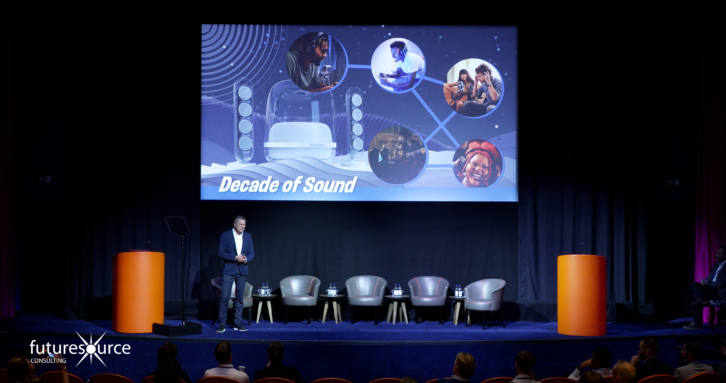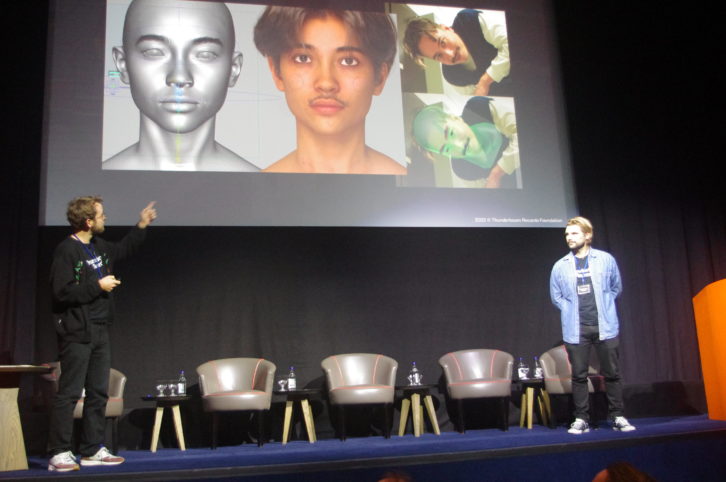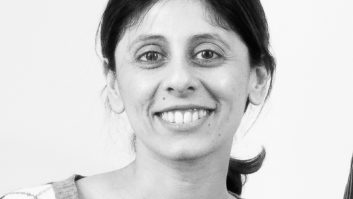Sound as a technology is having a significant influence, not just on entertainment but also people’s health and well-being. This development was discussed during Futuresource’s Audio Collaborative conference in London on November 10th, which looked at how sound and advanced devices were developing, its impact in gaming and personalised listening, with a spotlight on the crucial issue of sustainability.
Futuresource director of entertainment and consumer technology Carl Hibbert opened proceedings, observing that audio was a “rising technology”, which was seeing an appetite for content in both gaming and entertainment. This had been predicted at the last in-person Audio Collaborative in 2019 by Carsten Olesen, president of consumer audio at HARMAN International, who hailed the beginning of the “decade of sound”.

Olesen also delivered this year’s Opening Keynote, The Future Shape of Sound. Observing there had been “growth in all things audio” and that the world “never sounded better”, he said both wireless and fibre connectivity played a part, with increases in bandwidth offering “more availability of audio wherever we go.”
In a follow-up conversation with Hibbert, Olesen remarked to Installation that “high end sound plays a significant role”, with higher density and immersive capability featuring on listener devices. “Listeners are very well aware of spatial and high quality audio now,” he said, adding that both artificial intelligence (AI) and the metaverse have roles to play but that, conversely, audio would humanise these technologies. “Audio will bring life into the metaverse, which is not to downgrade the video experience. But it would mean very little without spatial audio.”
Audio and other home technologies received a boost during the pandemic as people spent money to create the best possible entertainment environment. “There was a Covid boom for home audio,” commented Futuresource lead market analyst Chris Bull. “The period Q2 2020 to Q3 2021 saw unusually heightened activity and we’re yet to see the ceiling. There is more growth to come.”
SOUND HEALTH
The effects of sound on health were discussed in The Power of Audio: The Impact of Advanced Audio Technologies on Well-being. Moderator Matt Murray of DSP Concepts outlined the problems of increased headphone use, quoting World Health Organisation figures showing 20 percent of the global population now suffering from some form of hearing loss. Al Ganeshkumar, lead audio system design engineer at Starkey Hearing, commented such impairments “had long term implications for health”, from people being not fully engaged to contributing to dementia.
Philipp Skribanowitz, CEO of Mimi Hearing Technologies, observed it was necessary to look at why the world was seeing high instances of hearing loss, citing eight hours a day of digital audio consumption as a factor. “We need to start earlier [in alerting people to potential problems] and prevent it,” he said.
Matt Marchese, senior director of sales for the Americas at Tymphany, noted there was – or had been – a stigma attached to hearing aids but that over-the-counter (OTC) hearing aids and more design conscious devices could change that. Sebastian Scharrer, head of product management, consumer audio with Fraunhofer IIS, raised the issues of “necessary noise” and length of use of TWS (True Wireless Stereo) earbuds in vehicles, while acknowledging the growing need for dialogue enhancement on home devices due to extended exposure to high sound levels.
The increased use of headphones and other in-ear devices was reflected in the presentation The Audio Industry in Numbers. Futuresource market analyst Arian Bassari explained there had been an 11 percent increase in the global consumer audio market, from $78 billion in 2021 to $86 billion in 2022. Headphones accounted for 64 percent of this rise, with home audio at 28 percent, loudspeaker six percent and gaming two percent.
SPATIAL AUDIO
Spatial audio featured heavily in The Next Big Thing: Home Audio. Marcos Simón, CTO at 3D audio developer Audioscenic, commented that spatial sound and its practicality were important, with Apple now pushing the format. Julien Bergere, global portfolio planning director with Bang & Olufsen, said it was part of the audio industry’s responsibility to help people experience new qualities, including immersive and interactive sound.
Rob France, head of global content engineering for Dolby, pointed out gaming had been 3D for some time but that the field was continuing to change, with more immersive audio and a move towards communal operation rather than “hyper personalisation”. Sarah Yule, commercial director at KEF, remarked this was “an audio first world” right now, with sound being important to both Instagram and TikTok. She added that there was still a place for acoustics and physics in designing systems, particularly for the in-car market when rethinking how loudspeaker drivers work.
The panel session Pushing the Boundaries of the Personal Audio Experience opened with a blunt question from moderator Jonny McClintock of Audio Codecs: “Do we need better audio?” Matt Windmill, sales manager for consumer (EMEA) at Analog Devices, gave a resounding yes: “For TV the soundbar has almost led the way for the consumer. If you watch something like Game of Thrones, the difference between a TV loudspeaker and a soundbar is like night and day.” He added there was “still a way to go”, particularly when it came to spatialisation, which he sees as a “step to a more immersive experience”.
Helmuts Bems, CEO of audio measurement specialist Sonarworks, commented there had been an “era of convenience” in audio technologies, which was now changing. “There is more attention to quality of experience,” he said. Jon Kiachian, VP and general manager for hearing health technologies at Knowles Corporation, observed that both tethered and wireless earphones had “done a good job” in pushing the benefits of better quality, with research showing more people wanted to hear above approximately 10kHz.
COVID CONTENT
The pandemic came up in almost every session, including Opportunities for the Content Creation Industry Following the Return to a ‘New Normal’. Andy Allen, marketing director of mixing console and interface manufacturer Audient, explained that lockdown “shone a spotlight on home recording” as people bought equipment for streaming, podcasts and gaming, with social media now the biggest driver of content creation through the use of smartphone to make videos for TikTok and other platforms. Harman’s Phil Cummings confirmed the demand for professional equipment as musicians looked to put on gigs from home during the pandemic. “It’s now moved on to podcasters and gamers,” he added.
The need to make the audio industry more ecologically aware was highlighted into two sessions, beginning with a presentation by Shure’s sustainability champion, Althea Ricketts. She opened by saying the “new destination” for companies was zero emissions and later joined the panel session Sounding Out on Sustainability to note that people in the audio sector were becoming more aware of the world beyond their own walls.

Dom Robinson, co-founder of international awareness forum Greening of Streaming, gave the shocking statistic that streamed services were consuming two to three percent of the world’s energy, the same as the aviation sector. “The important thing with digital media and sustainability is that you have to think systematically,” he said, explaining that people could no longer just focus on their own activities. As Andy Dowell, head of licensing at rendering technology developer MQA, observed there was a considerable impact from “everybody watching Netflix during the pandemic” but that music streaming was also a culprit.
The history and future of sound for video games was outlined in Making More of Audio for Gaming. Simon Byron, director of publishing at Yogscast Games and Michael Kelly, senior director of engineering for immersive audio developer DTS discussed the early days of no or little sound in games, though the hobbyist period of four and eight track recordings to the cinema-style productions and full-blown music-based experiences of today. Immersive is the next logical step and Kelly commented that today’s consumers had become “very educated” about what it is and can do. “It’s only just happening but once we get it right and then take it away, people want it back,” he said. Byron observed that gamers wanted ways that either gave them an advantage in their play or made them better at a game. “Spatial audio in games and esports allows them to recognise where something is happening in the soundspace,” he explained.
VOICE ACTIVATION
Voice activation was mentioned through the day and examined in more depth in Voice Update – Look Who’s Talking, presented by Simon Forrest, principal technology analyst at Futuresource. In 2022, Google Assistant had 35 percent of the Virtual Assistant platform market, with Siri at 23 percent, Baidu DuerOS (a leading player in China) eight percent and Alexa four percent. Forrest explained what might seem a low share by saying Alexa also featured in the ‘Multiple’ category (16 percent) and was “becoming larger and coming of age”.
A potential future direction for audio was laid out in the Closing Keynote address, presented by Joost de Boo and Max Tiel of Dutch record label Thunderboom Records. Thunderboom is described as a ‘robot record label’; Tiel explained the aim was to use technology in general – and AI in particular – to benefit human creativity. To do this, the company has created a fictional, virtual musician called Fi to collaborate with human musicians. Thunderboom also developed Waive, a virtual instrument and production tool that works on AI-generated patterns. De Boo said Thunderboom was now developing augmented reality, hologramatic shows for any artist to utilise, with the first to take place in February next year.







